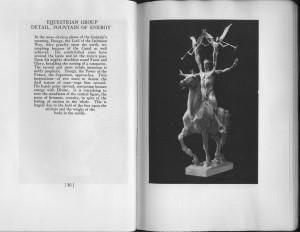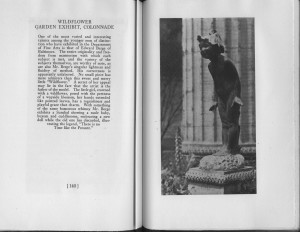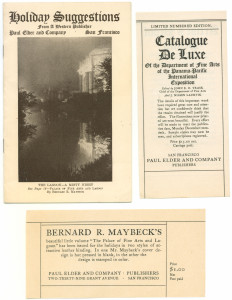
In addition to his books, Paul Elder & Co. produced a large amount of ephemera: greeting cards, postcards, catalogs, bookmarks, etc. Here is a small sampling of ephemera featuring the Panama-Pacific International Exposition.

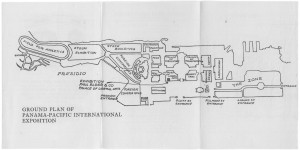
San Francisco bookseller & publisher, 1898-1968

In addition to his books, Paul Elder & Co. produced a large amount of ephemera: greeting cards, postcards, catalogs, bookmarks, etc. Here is a small sampling of ephemera featuring the Panama-Pacific International Exposition.



In the early 19th century, mathematicians such as Joseph-Louis Lagrange and William Rowan Hamilton began exploring fourth dimensional space. By mid-century, the idea that time was the fourth dimension began to appear in literature. It was Edgar Allan Poe who first wrote that “space and duration are one” in his 1848 essay Eureka. James Clerk Maxwell, famous for mathematically describing how light, electricity, and magnetism were all facets of the same underlying phenomenon, was also a poet. In 1878, a year before his death, he wrote “Since all the tools for my untying / In four-dimensioned space are lying, / Where playful fancy intersperses / Whole avenues of universes.” In his 1888 book A New Era of Thought, mathematician and science fiction author Charles Howard Hinton coined the term tesseract for the fourth-dimensional analog of a three-dimensional cube. (The term was famously borrowed in 1963 by Madeleine L’Engle in her novel A Wrinkle In Time.) Soon many authors, including such luminaries as Marcel Proust, Fyodor Dostoyevsky, Joseph Conrad, Oscar Wilde and H. G. Wells began writing about the fourth dimension: sometimes evoking geometry, but usually equating it with time.
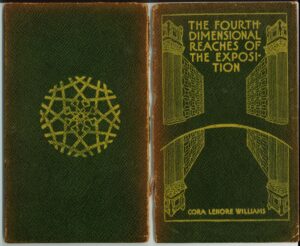
In The Fourth-Dimensional Reaches of the Exposition (1915), Cora Williams takes her stab at the mysteries of the fourth dimension, broadly invoking the monumental scale of the Panama-Pacific International Exposition’s fairgrounds.
The human mind has so long followed its early cow-paths through the wilderness of sense that great hardihood is required even to suggest that there may be other and better ways of traversing the empirical common. So it is that the fear of being proclaimed a Brazenhead has restrained me until this eleventh hour from telling of my discoveries concerning the fourth-dimensional reaches of our Exposition.

This is indeed an odd little book. Williams writes with a florid mysticism:
While many books have been written descriptive of the Exposition, none has succeeded in accounting completely for the joy we have in yonder miracle of beauty. … There is still a subtle something not spatialized for consciousness. Length, breadth, and height do not suffice to set forth the ways of our delight in it. … Obviously to give it extension we shall have to ascribe to reality other dimensions than those of our present sense-realm. … Although the scientist has found it useful on occasion to postulate the fourth dimension, he has not thought necessary as yet to put it in the category of reality; much less has the layman.
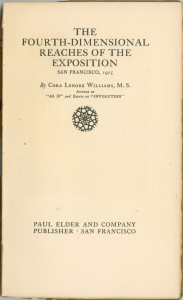
Later, Williams muses about the beginning of life on Earth:
All we need in order to come to a fourth-dimensional consciousness, said Henri Poincaré, is a new table of distribution … a breaking up of old associations of ideas and the forming of new relations. … Lester Ward speculates that life remained aquatic for the vast periods that paleontology would indicate; Cambrian, Silurian, Devonian and Carboniferous—a duration greater than all subsequent time. Life was not able to maintain itself on land until it had overcome this one-dimensional limitation. … A venturesome Pterodactyl was who first essayed to make his way among the many obstructions to be found ashore! By what intuition was he impelled?
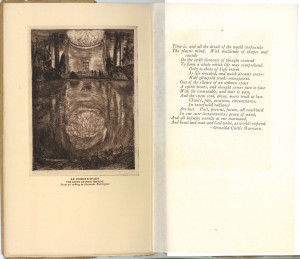
In the title chapter, she discusses the Fair itself. This section is notable for containing one of the earliest occurrences in print of the word “hyperspace”:
The Panama-Pacific International Exposition is best seen in its fourth-dimensional aspect when approached through the Gateway of Memory. This is what one might expect, for that entrance alone has the requisite geometrical structure. You will recall having head, I am sure, how in the fourth dimension a person may go in and out of a locked room at his pleasure with bolts and bars untouched. Broad and open as is this Gate of Memory, when you pass its portals the wall closes behind you; there is no visible opening to mark the spot of your entry. A feeling of detachment comes over you. This is augmented by the burst of light and color that flashes across the field of your vision, and for the first time you understand the purport of those ‘banners yellow, glorious, golden’ which ‘do float and flow.’ They seem to bear you on breezes of their own creating to the freedom of outer spaces. What you had taken for the flauntings of festivity are become the heralds of hyperspace.
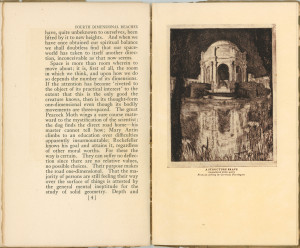
During her lifetime, Cora Lenore Williams (1865-1937) was known primarily as an educator. In 1917 she acquired the John Hopkins Spring mansion in Berkeley, which she turned into the Institute for Creative Development (later Cora Williams Institute), a fancy school specializing in languages, poetry, music, and literature. Williams also wrote one other book for Paul Elder, As If (1914).
Frontispiece artist Gertrude Partington Albright (1874-1959) was born in Heysham, England and received artistic training from her father, the artist John H.E. Partington. Her family moved to San Francisco, California in 1880. She returned to Europe to study at the Academie Delecluse, and later opened a studio at 220 Post Street where she did her painting and printmaking. She married artist Herman Oiver Albright in 1917 and joined the faculty at the California School of Fine Arts where she taught until her retirement in 1946. She exhibited at the Salon International des Beaux Arts, Carnegie Institute, Corcoran Gallery and the 1915 Panama Pacific Exhibition where she was awarded a bronze medal for painting.
Ormeida Curtis Harrison (1875–1947) was a poet and assistant principal at the A-to-Zed school in Berkeley. She was second wife of author and naturalist Charles Keeler. Her poem “Time Is” appears on the tissue guard between the title page and frontispiece.
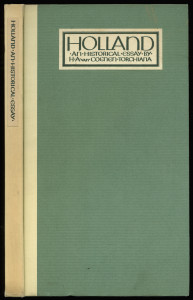
From what source did the forefathers of modern America acquire the high ideals of government and right living that made the American Republic first a possibility, and finally a proved realization? … One nation, and one only, in the whole of Western Europe, at the time of the founding of the New England Colonies, embodied the ideas that have become an integral part of American civilization. The Netherlands had been for centuries the home of religious freedom and toleration, or representative government, and of political liberty.
So wrote H. A. van Coenen Torchiana in the first chapter of Holland: An Historical Essay (1915). While Americans might blithely think that our former colonial overlord—the Kingdom of Great Britain—was the source of our democracy, Torchiana begs to differ. In a later chapter, “The Debt of the United States to the Netherlands,” he lists various American institutions that we take for granted, but which originated in Holland: free public schools including universities, health care for the poor and needy, assistance for war widows and orphans, work programs for prisoners, relative equality for women, and even the American peace treaty policy.
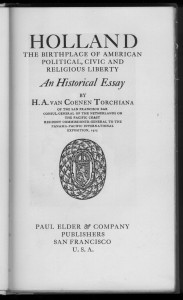
Holland was published in green paper on boards, with cover and spine paste-downs in a lovely uncial typeface. It probably was issued with a dust-jacket, not seen by me.
Henry Albert van Coenen Torchiana (1867-1940) had a long and interesting career. He was born on the island of Java, then part of the Dutch East Indies. After graduating from the Amsterdam College of Commerce in 1890, he came to the United States in with his wife, Catherine Geloudemans, and became a naturalized citizen in 1895.
In the 1890s Torchiana became manager of the extensive Miller & Lux land holdings. He was admitted to the bar in 1900 and from 1910-16 he was a member of the firm of Stratton, Kaufman and Torchiana. In 1913 he was appointed Consul General in San Francisco for the Netherlands, a post he would hold until his death. He was resident commissioner-general of the PPIE, dean of foreign commissioners in 1915, and controller of Netherlands’ navigation on the Pacific Ocean from 1916 to 1919.
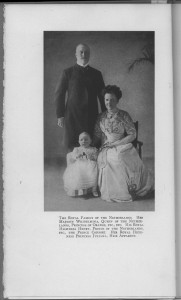
Torchiana wrote two other books for Paul Elder, California Gringos and The Story of the Mission of Santa Cruz.

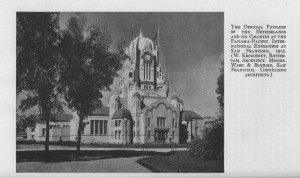
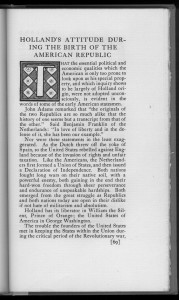
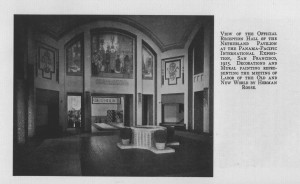
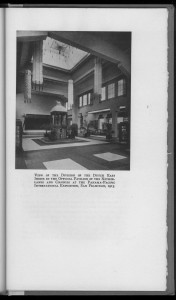
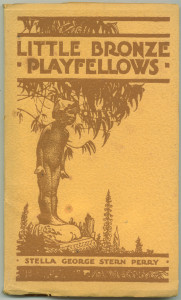
In Little Bronze Playfellows (1915), author Stella Perry creates fanciful children’s stories based on several of the bronze statues of children scattered about the grounds of the Palace of Fine Arts. It is one of a dozen books issued by Paul Elder during 1915 Panama-Pacific International Exposition.
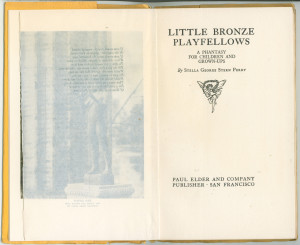
The bronze boys and girls are all gamboling about while perfectly naked. For a statue that was not unusual, as a great deal of the of Fair’s sculptures featured naked adults. But notwithstanding the anachronism of classical statuary in modern times, one senses that statues of naked children wouldn’t be so well received in our politically sensitive age.
The book was issued in gold-colored wraps, with a dozen photographic plates (not tipped-in, as in many other Elder publications). The cover illustration, as well as the plate opposite page 10, is the statue “Wild Flower, by Edward Berge. (The statue also appears on page 140 of Perry’s The Sculpture and Mural Decorations of the Exposition.) Unusually for Elder, the book does not have a colophon.
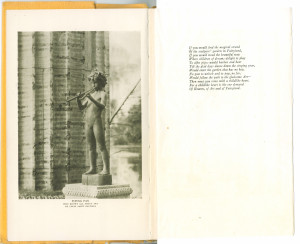
Stella George Stern Perry (1877-1956) was an American author, suffragist, and social reformer. She graduated from Barnard College, where she was one of four co-founders of the Alpha Omicron Pi sorority. She also wrote another children’s book for Paul Elder, The Clever Mouse (1916).
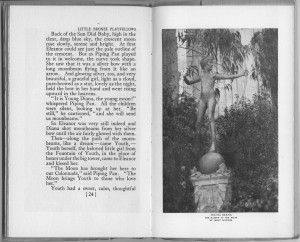
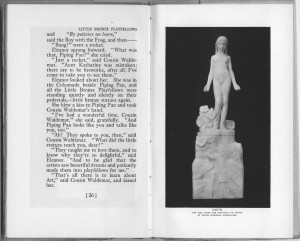

As with the other three books in Paul Elder’s quartet of formal books on the Panama-Pacific International Exposition, The Sculpture and Mural Decorations of the Exposition (1915) consists primarily of tipped-in photographs with accompanying descriptive text. A. Stirling Calder, the “Acting Chief of Sculpture of the Exposition,” has name is on the cover, but his contribution consists of a ten-page Introduction. All of the other text is by author Stella Perry.
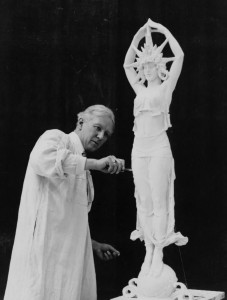
Alexander Stirling Calder (1870-1945) was an American sculptor and educator. He was the son of sculptor Alexander Milne Calder, known for his sculptures in Philadelphia City Hall, and the father of Alexander Calder, inventor of the mobile. Calder created many pieces for the Fair, including the well-known “Star Maiden,” which curiously does not appear in this book. The model for Star Maiden was Audrey Munson, who was then at the height of her fame; it has been claimed that she posed for as many as three-quarters of the Fair’s statues. (In 1915, Munson also became the first woman to appear nude in a non-pornographic film.)
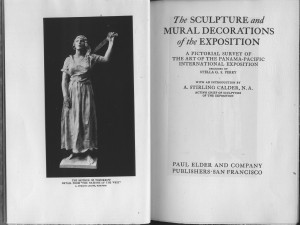
Stella George Stern Perry (1877-1956) was an American author, suffragist, and social reformer. She graduated from Barnard College, where she was one of four co-founders of the Alpha Omicron Pi sorority. She wrote two children’s books for Paul Elder, Little Bronze Playfellows (1915), and Clever Mouse (1916).
